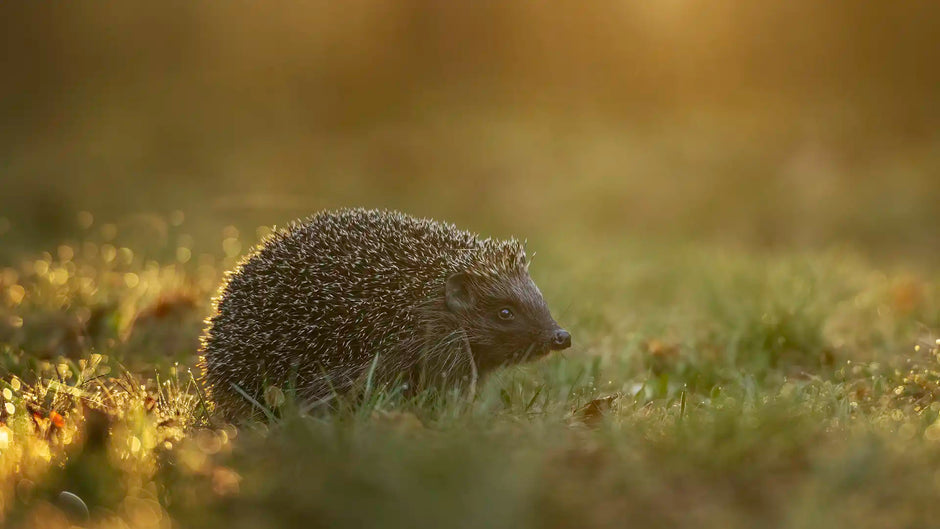Step outside at dusk in most UK towns, and you might catch a glimpse of russet fur darting down a pavement or disappearing in an alley. Urban foxes have become a familiar, if mysterious, part of city and suburban life, yet they remain largely misunderstood. Are they dangerous? Will they attack pets? Should we feed them? At Ark Wildlife, we’ve spent years observing, supporting, and documenting these clever creatures. In this guide, we share the truths behind the myths, the fascinating behaviour of urban foxes, and how we can coexist safely.
One Species, Two Worlds
Urban and rural foxes are both Vulpes vulpes - the red fox - yet they live in worlds as different as London and the Lake District. The contrast is even sharper than that between city and rural life for humans. We take our services with us: heating, food, medicine, clean water. Foxes have none of that. Where they’re born shapes everything about their survival.
City Life: Abundance and Risk
Urban foxes enjoy year-round food: warm microclimates that sustain insects, fallen fruit, compost, gardens rich in earthworms, and the leftovers of our convenience culture. But the trade-offs are steep. Close living spreads mange more easily, road collisions are a constant danger, and competition between foxes is fierce.

Countryside Life: Space and Scarcity
Rural foxes cover wider territories, face harder winters, and rely far more on hunting, seasonal skill and solitary survival. They encounter fewer cars but face different dangers - including legal pest control in some areas. Life is quieter, but no less risky.
In the End: Same Species, Different Lives
Urban foxes often live shorter, more precarious lives due to traffic and disease pressure, even though food is plentiful. Rural foxes live closer to natural rhythms and rely heavily on instinct and opportunity. One species, two worlds - shaped entirely by habitat.
Diet: Opportunism at Its Finest
Urban foxes are opportunists, but not bin-raiders alone. Over half their diet remains natural: earthworms, beetles, small mammals, fruit, and berries. In rural landscapes, prey like voles, rabbits, and invertebrates form the core of their diet, supplemented by seasonal fruit, nuts, and scavenging.
Myth Buster: “Urban foxes live on rubbish.”
False. They still forage primarily on natural foods.

Home: From Woods to Back Gardens
Rural foxes live in holes called ‘dens’ made in earth banks, hedgerows, and woodland burrows. Urban foxes repurpose whatever they can find, a space under a shed, a quiet patch behind garages, road and railway embankments, abandoned structures. They are masters of turning forgotten corners into shelter.
Tameness: Bold, Not Domesticated
City foxes appear bolder simply because they see us more often. Noise, scent, and human activity become part of their world. But bold doesn’t mean tame, they remain wary, alert and entirely wild. Rural foxes simply have fewer encounters with us, so they appear more elusive retreating from view long before we are aware of their presence.
Myth Buster: “Urban foxes are abandoned pets.”
False. They’re wild animals which have simply adapted to living near people.
Health & Numbers: Dustbin Foxes? Think Again.
Urban foxes are often in good condition thanks to reliable food sources. They are not starving scavengers. However, their population densities are higher (more foxes per square kilometre) because cities offer more food.
But density is not population size. The majority of the UK’s red foxes still live in rural areas.
Myth Buster: “There are more foxes in cities than the countryside.”
False. Cities have higher densities of population, but rural areas contain more foxes overall.

Fox Facts: The Real Lives of Red Foxes
How Foxes Live & Communicate
Foxes live in small family groups, not packs. One dominant pair breeds, while subordinate adults often help raise the cubs. They hunt alone but remain socially connected.
Their voices reveal their world:
- The blood-curdling winter scream is a vixen calling during mating.
- Short barks are contact calls.
- Rapid “kek-kek” sounds serve as warnings.
Once you know their language, a whole nocturnal conversation emerges.
Reproduction & the Fox Year
- Mating: January–February
- Cubs born: March
- First emergence: Late April
- Summer: Learning, playing, exploring
- Autumn: Dispersal to new territories
Most foxes live only 2–3 years in the wild, though some reach 9–10.
Cunning & Hunting Skills
Their ‘cunning’ is instinct powered by extraordinary senses. Using their keen eyesight, sense of smell and hearing, foxes can detect prey under snow, soil, or dense vegetation. Some researchers believe they may use the Earth’s magnetic field to judge distance before pouncing, a truly remarkable adaptation.
Their delicate walking pattern, with part-retracted claws, leaves neat prints and allows near-silent approach.
Are Foxes Dangerous?
Serious attacks on humans are extremely rare. Foxes avoid confrontation whenever possible. Cats are almost always safe; smaller pets should be housed securely, a precaution against instinct, not malice.
When foxes kill multiple chickens, it isn’t “for fun” it’s survival behaviour. Given the time the fox would return to collect and ‘cache’ each carcass, storing excess food while opportunity is high, returning to stored food when other sources are depleted.
Myth Buster: “Foxes kill for pleasure.”
False. It’s instinctive caching behaviour seen in many predators.

Behaviour in Your Garden
Understanding fox behaviour turns fear into fascination - and helps us coexist.
Why Foxes Scream at Night Ark
If you’ve ever been jolted awake by a sharp, blood-curdling scream in midwinter, you’ve likely heard a fox - not someone in danger. This sound is most often a vixen calling for a mate, part of the fox mating season that runs from December through February, with the peak in January.
These screams serve as long-distance contact calls, carrying across streets, gardens, and open spaces on cold night air. They can continue intermittently for several nights as local males respond, moving through territories and announcing themselves with their own brief barks.
During this season, you’ll also hear:
- Short, sharp barks — usually from dog foxes advertising their presence.
- Rapid “kek-kek-kek” calls — warning signals or territorial disputes.
- Low growls and whimpers — heard more rarely, often between courting pairs.
Although dramatic to us, this winter chorus is completely normal. It’s simply how foxes find each other, establish pair bonds, and negotiate the complex social dynamics of mating.
Digging & Fouling: What’s Normal?
Foxes dig for worms, beetles, and grubs, or to hide food. Scat left in visible places is a territorial marker. These behaviours are natural, precise, and part of their resourceful lifestyle.
Garden lawns offer good foraging and sometimes small holes may appear overnight along with a pungent musky poo deposited in a prominent position. It’s the foxes equivalent of leaving a tip on the table following a good meal.
Dens & Daytime Sightings
Urban dens often appear under sheds, in brambles, behind garages, or along railway edges, increasing the likelihood of daytime sightings.
Daytime sightings are also common, especially when adults are rearing cubs, or during hot weather when sunbathing or shade might be sought.

FAQs: Myths, Meaning & Misunderstandings
The ‘Sly Fox’: Myth vs Reality
From medieval tales to Aesop’s fables, the fox has been cast as a trickster.
In truth, their intelligence is simply adaptability, problem-solving under pressure in a human-shaped world. The fox isn’t sly, it’s ingenious, and its a survivor.
Do Urban Foxes Carry Diseases?
- Foxes in the UK do not carry rabies
- Mange occurs, but risk to humans is low
- Mange-afflicted foxes can recover if well-fed
Should You Feed Urban Foxes?
Feeding can help during hard weather, but must be responsible:
- Offer quality over quantity
- Keep feeding areas away from doors
- Never hand-feed
- Suitable foods: Ark Fox Food, dog food, or a handful of peanuts or calcium worms
Our philosophy is simple: feeding should supplement, not replace, natural diet and behaviour.
Do Foxes Attack Pets: Are Cats and Dogs at Risk?
Foxes avoid confrontation.
Cats are agile enough to avoid them, and dogs are rarely threatened unless a fox is cornered or defending cubs.
We have countless examples of cats and foxes meeting at night and cats have always controlled the space. Foxes seeking food remain uninterested in drama or confrontation.
Are Urban Foxes ‘Dumped’ or Unhealthy?
Urban foxes are neither abandoned pets nor unhealthy outcasts. They’re wild animals thriving through intelligence, adaptability, and opportunity.
Key Takeaways:
- Urban foxes are wild
- City life offers warmth and food
- They help control rodents and insects
Why Are Their So Many Foxes in Our Towns?
Foxes succeed in cities because they are:
- Intelligent problem-solvers
- Social and cooperative
- Opportunistic feeders
- Flexible in denning and movement
Urban areas simply match their natural strengths.
Urban Foxes and Us: Coexistence, Not Conflict
Foxes remind us that nature endures even in the busiest city centre. By understanding rather than fearing them, we can share our space responsibly.
Tips for Peaceful Coexistence:
- Secure bins and compost
- Keep pet food indoors overnight
- Block unused den sites if needed, but leave wild corners for natural shelter
- Observe quietly; foxes reveal their secrets to patient watchers
Final Thoughts: Clever Survivors in a Human World
Urban foxes are not invaders, they’re adapters. They’ve learned to survive on the edges of our lives, using instinct, intelligence, and quiet determination.
At Ark Wildlife, we believe coexistence begins with curiosity. Whether you’re watching foxes from the window, feeding garden birds, or sheltering hedgehogs, you’re part of the same quiet story - nature always finds a way.
Every garden is part of a larger natural story, and foxes are one of its most remarkable chapters.












